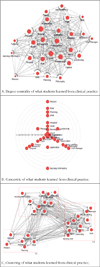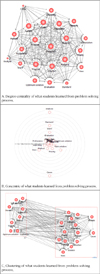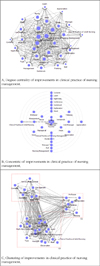Abstract
Purpose
The purpose of this study was to analyze students experiences during clinical practice in nursing management.
Methods
Assessing through computerized databases, self-reflection reports of 57 students were analyzed. Text network analysis was applied to examine the research. The keywords from each student's reports were extracted by using the programs, KrKwic and NetMiner.
Results
The results of the keyword network analysis of what students learned in the nursing process included 27 words. The keyword network analysis of what students learned from the problem solving process included 23 words and the keyword network analysis of improvements in Clinical Practice of Nursing included 31 words.
Conclusion
Studies related to clinical practice have been increasing, and themes of the studies have also become broader. Further research is required to investigate factors affecting clinical practice specifically in nursing management. Further comparative studies are necessary to define differences in clinical practice systems related to improving nursing students competency.
Figures and Tables
References
1. Jang KS, Park SJ. Effects of action learning approaches on learning outcomes in nursing management courses. J Korean Acad Nurs Adm. 2012; 18(4):442–451. DOI: 10.11111/jkana.2012.18.4.442.
2. Jho MY. An analysis of research on nursing practice education in Korea. J Korean Acad Soc Nurs Educ. 2010; 16(2):239–248.
3. Kim YM, Kim YH. Development and evaluation of action learning in clinical practice of nursing management. J Korea Contents Assoc. 2010; 10(6):312–322.
4. Kim EK, Kim SY, Jung MS, Jang KS, Kim JH, Kim JK, et al. Current status and considerations for education in nursing management. J Korean Acad Nurs Adm. 2011; 17(2):238–246. DOI: 10.11111/jkana.2011.17.2.238.
5. Davidson PM, Elliott D, Daly J. Clinical leadership in contemporary clinical practice: Implications for nursing in Australia. J Nurs Manag. 2006; 14(3):180–187. DOI: 10.1111/j.1365-2934.2006.00555.x.
6. Sharif F, Masoumi S. A qualitative study of nursing student experiences of clinical practice. BMC Nurs. 2005; 4:6. DOI: 10.1186/1472-6955-4-6.
7. Choi YC, Park SJ. Analyzing trends in the study of public administration: Application of the network text analysis method. Korean Public Adm Rev. 2011; 45(1):123–139.
8. Kim BH, Kim JS. Analysis of articles related STEAM education using network text analysis method. J Korean Elementary Sci Educ. 2014; 33(4):674–682. DOI: 10.15267/keses.2014.33.4.674.
9. Decision making, problem solving, and critical thinking: Requisites for successful leadership and management. In : Marquis BL, Huston CJ, editors. Leadership roles and management functions in nursing: Theory and application. 7th ed. Philadelphia, PA: Lippincott Williams & Wilkins;2012. p. 1–29.
10. Korea Astronomy & Space Science Institute. Media image analysis of The Korea Astronomy and Space Science Institute on the Naver news. KASI INSIGHT, 2013-6. Daejeon: Korea Astronomy & Space Science Institute;2013.
11. Kim M, Noh S, Ryu E, Shin S. Research trend analysis of Do-Not-Resuscitate decision: based on text network analysis. Asian Oncol Nurs. 2014; 14(4):254–264. DOI: 10.5388/aon.2014.14.4.254.
12. Lee SK, Jeong S, Kim HG, Yom YH. A social network analysis of research topics in Korean nursing science. J Korean Acad Nurs. 2011; 41(5):623–632. DOI: 10.4040/jkan.2011.41.5.623.




 PDF
PDF ePub
ePub Citation
Citation Print
Print







 XML Download
XML Download